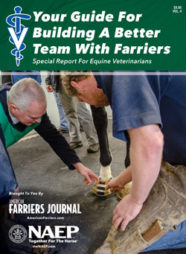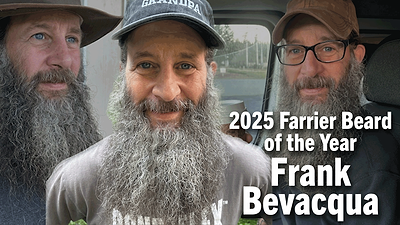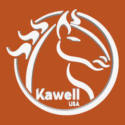After a day of shoeing, Henry Heymering huddled at his kitchen table in early 1975 putting together the first issue of American Farriers Journal.
There was a resurgence in the horse population and farriers, yet there was a void in sharing knowledge. The Arcadia, Fla., farrier wanted to change that. Heymering filled 8 pages with a case involving a tunnel he found while trimming, product reviews, tire maintenance and a tool modification. AFJ collected 54 paid subscriptions in the first year. By the second, it climbed to 250. Heymering’s hunch that farriers were eager for information proved correct.
As AFJ marks its golden anniversary, we’re reflecting on the relationships and partnerships we’ve forged, the milestones and the lessons we’ve learned along the way. They range from joyful to painful. Among the latter is the March 8, 2025, passing of Pam Lessiter, who co-founded Lessiter Media — publisher of AFJ — with her husband Frank. Moments like these often lead us to ponder, what if? You might recall that George Bailey was shown what Bedford Falls, N.Y., would be like if he’d never been born in the Frank Capra film, It’s a Wonderful Life.
 Jimmy Stewart stars as George Bailey in It's a Wonderful Life.
Jimmy Stewart stars as George Bailey in It's a Wonderful Life.“Strange, isn’t it?” Clarence Oddbody, Angel Second Class, tells Jimmy Stewart’s George Bailey. “Each man’s life touches so many other lives. When he isn’t around, he leaves an awful hole, doesn’t he?”
We pondered the question, what would the farrier industry be like without American Farriers Journal?
“Farriery is an art and a science,” says Frank Lessiter, who is entering his 33rd year as owner of AFJ. “We’ve helped farriers learn new things. We’ve opened the door for farriers to learn from one another. Technologies have thrived because AFJ has helped bring it along. Farriers are doing research today who never would have done so years ago. The industry wouldn’t have grown without AFJ and wouldn’t be as professionally accepted by others in hoof care.”
Going to Farriers
After investing significant time and effort over the years into AFJ, Heymering’s schedule of shoeing horses full-time and publishing the magazine was taking its toll. He sold AFJ in 1980 to Dean Laux, a Massachusetts publisher. He continued as a consulting editor for 2 more years while maintaining his shoeing book.
After 11 years, Laux didn’t see the anticipated return and sought a buyer. Frank and Pam Lessiter jumped at the opportunity. Horses were staple in Frank’s formative years while growing up on a Michigan farm that relied on drafts. His family-owned company was publisher of two agricultural publications, an equine hoof-care magazine was a logical step.
“Frank could have taken his dollars and thrown them in a mutual fund market and made more of a profit than he did in this publishing enterprise,” says Mike Lessiter, Frank and Pam’s son and now president of Lessiter Media. “This never was about money. It was Frank using his skills and commitment in a market that needs information. He’s done this his whole career.”
Frank’s experience told him there was fertile, untapped ground for cultivating critical hoof-care information for the AFJ audience.
“When Laux had AFJ, they didn’t go out in the field,” he recalls. “After we’d bought AFJ, I attended a no-till agriculture meeting and visited Gary Faulkner in Maryland. Driving back to the airport, I decided we should do a Shoeing for a Living. It wasn’t called that yet. Gary was the first one.”
Shoeing for a Living offered a glimpse into the typical day of a working farrier. The installments are relatable because many farriers encounter similar issues, but they also reveal various ways to tackle them that they might not have considered.
“It showed the industry we were willing to get out from our desks and talk with people about a typical day and what they’re doing,” Frank says. “The fact we were not farriers was a plus. Some farriers started magazines and followed their narrow niches on how to do things. They didn’t work out.”
Improving Business
Today, AFJ is the world’s largest repository of equine hoof-care information covering breeds and disciplines, trimming, shoeing, forging, diseases and lameness, safety and healthcare, nutrition and business management.
“Pricing was a big issue,” Frank says. “Some farriers might have gone out of business if they didn’t read about how to run a business and improve their revenue.”
The advent of modern materials found a friend in AFJ. The technologies opened the eyes of many farriers when they realized they had more options.
“New Jersey farrier Ian McKinlay is a good example,” Frank recalls. “People knew what he was doing, but they didn’t have the details. I did a Shoeing for a Living with him in New York City. All of a sudden, people started thinking about it. We got calls, ‘Where do I get these patches? Where do I get these clips?’”
Hoof-care education became easily accessible. The experiences and wisdom of farriers and veterinarians are at your fingertips. Walt Taylor credits AFJ and the organization he founded as the sparks that propelled the farrier industry into the 21st century.
“Besides the existence of the American Farrier’s Association as a structured organization since 1971, there has been nothing else as important to the renaissance of footcare and farriery as the American Farriers Journal,” he says. “The two organizations, working in concert with each other, have fostered the well-being we enjoy today. By and large, the work we do now is light-years ahead of what it was 50 years ago, and as different now compared with then as the proverbial ‘chalk and cheese.’ There is no question that the time was right for birth and robust youth of both enterprises. Those of us who were fortunate enough to be part of this growth and development enjoy an advantage over those whose careers began later. Not only have we had the opportunity to share with and lead others in learning and skills development, we had the opportunity to develop and share a whole new dimension of learning and practicing this facet of equine care and welfare.”
Read more from "What If American Farriers Journal Didn't Exist?"
What do you think? Where would the farrier industry be if American Farriers Journal never came to be? Share your thoughts by emailing jcota@lessitermedia.com.







